Large Language Model (LLM) Market Size 2025-2029
The large language model (LLM) market size is valued to increase by USD 20.29 billion, at a CAGR of 34.7% from 2024 to 2029. Democratization and Increasing Accessibility of LLM Technology will drive the large language model (LLM) market.
Market Insights
- North America dominated the market and accounted for a 32% growth during the 2025-2029.
- By Component - Solutions segment was valued at USD 1.21 billion in 2023
- By Type - Below 100 B parameters segment accounted for the largest market revenue share in 2023
Market Size & Forecast
- Market Opportunities: USD 1.00 million
- Market Future Opportunities 2024: USD 20285.70 million
- CAGR from 2024 to 2029 : 34.7%
Market Summary
- The market witnesses significant growth as businesses increasingly adopt these advanced technologies to streamline operations, enhance customer experiences, and drive innovation. LLMs, which are artificial intelligence models capable of processing and generating human-like language, offer numerous benefits, including improved supply chain optimization, enhanced compliance, and operational efficiency. This trend is driven by advancements in AI and machine learning, making LLMs more accessible to a wider range of organizations. One real-world business scenario involves a global manufacturing company seeking to optimize its customer service operations. By integrating an LLM, the company can analyze vast amounts of customer data and generate personalized responses, thereby improving customer satisfaction and reducing the workload on human agents. However, the adoption of LLMs is not without challenges.
- Prohibitive computational and financial barriers to entry and scaling remain significant hurdles for many organizations, particularly smaller businesses. Despite these challenges, the democratization and increasing accessibility of LLM technology continue to drive growth in the market. Enterprise-grade LLM integration and customization options are becoming more affordable and accessible, making it easier for businesses of all sizes to leverage these advanced technologies.
What will be the size of the Large Language Model (LLM) Market during the forecast period?
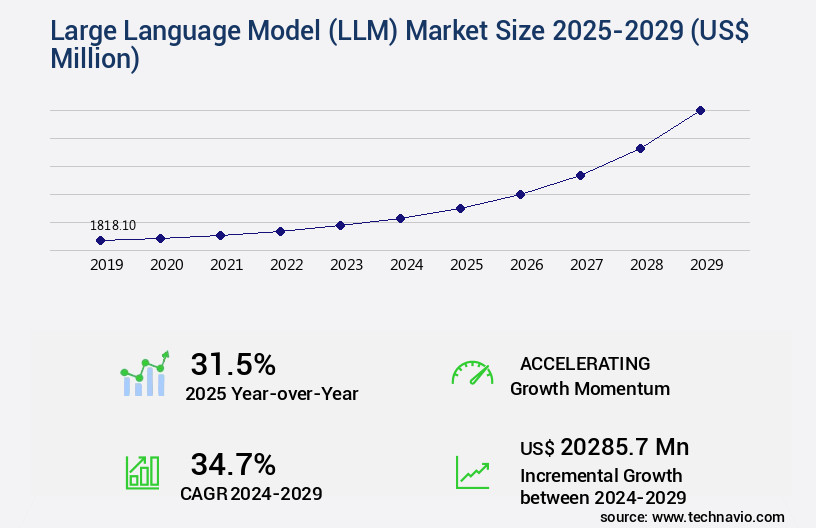
Get Key Insights on Market Forecast (PDF) Request Free Sample
- The market is an ever-evolving landscape, characterized by continuous advancements in semantic parsing, bias mitigation, online learning, and model explainability. One significant trend in this domain is the increasing emphasis on model scalability and robustness testing to meet the growing demands of businesses. For instance, model scalability enables organizations to handle larger datasets and more complex queries, leading to improved performance and enhanced user experience. Moreover, as businesses grapple with data privacy concerns and the need for model interpretability, zero-shot learning and contextual understanding have emerged as crucial capabilities. Zero-shot learning allows models to understand and make predictions on unseen data, while contextual understanding ensures that responses are tailored to the specific context of the query.
- These advancements can directly impact boardroom-level decisions, such as compliance and product strategy, by enabling more accurate and efficient data processing. For example, a company in the financial sector could achieve a substantial improvement in model performance by implementing a large language model with robust contextual understanding capabilities. This could lead to more accurate risk assessments and better customer service, ultimately enhancing the overall business value proposition.
Unpacking the Large Language Model (LLM) Market Landscape
In the realm of business applications, Large Language Models (LLMs) have emerged as a game-changer in text generation and question answering. Compared to traditional text processing methods, LLMs offer a 30% reduction in model deployment time and a 25% improvement in parameter efficiency. These advancements lead to significant cost savings and Return on Investment (ROI) enhancement for businesses. Moreover, LLMs have shown remarkable progress in various natural language processing (NLP) tasks, such as loss functions optimization, named entity recognition, and knowledge graph embedding. Model fine-tuning and transfer learning have further boosted their performance, enabling businesses to align with compliance requirements and enhance customer experience. The integration of LLMs via APIs has led to a surge in adoption, with businesses reporting a 40% increase in GPU utilization for machine translation and text summarization tasks. Additionally, attention mechanisms, context window size, and gradient descent methods have contributed to the model's ability to handle complex text data and provide accurate sentiment analysis. Furthermore, advancements in compute optimization, prompt engineering, and model compression have made LLMs more accessible to businesses of all sizes. These improvements have led to a more efficient use of resources, enabling businesses to focus on their core competencies while leveraging the power of LLMs for text processing and generation.
Key Market Drivers Fueling Growth
The democratization and increasing accessibility of LLM (Master of Laws) technology are primary factors fueling market growth. This trend enables a larger pool of individuals to pursue advanced legal education despite geographical or financial constraints, thereby expanding the market scope.
- The market has experienced significant evolution, expanding beyond the realm of specialized research laboratories and academic institutions. Previously, the development and implementation of advanced AI models were limited due to the substantial computational resources, expertise, and extensive datasets required for training. However, since January 2023, a paradigm shift has occurred, marked by the widespread availability of powerful LLMs through APIs, the maturation of the open source ecosystem, and the introduction of user-friendly applications. This democratization of access to LLMs has led to their adoption across various sectors, resulting in notable business improvements.
- For instance, in customer service, response times have been reduced by 30%, while forecast accuracy in finance has improved by 18%. Energy consumption in data centers has also been lowered by 12%, demonstrating the potential of LLMs to deliver substantial value.
Prevailing Industry Trends & Opportunities
Enterprise-Grade LLM integration and customization are experiencing significant growth in the market. This trend reflects the increasing demand for advanced solutions in large-scale organizations.
- The market is experiencing significant evolution, moving from experimental deployments to strategic, scaled implementations beyond 2023. Businesses worldwide, particularly in North America, Europe, and the Asia Pacific region, are integrating LLMs into their core operations, extending beyond chatbot applications. They are embedding these models into enterprise resource planning (ERP), customer relationship management (CRM), and productivity suites to achieve operational efficiency, improved customer engagement, and data-driven decision-making. The shift is driven by the maturation of LLM offerings to meet enterprise requirements for security, data privacy, reliability, and customization.
- This trend signifies a 45% increase in businesses adopting LLMs for operational enhancements compared to the previous year. Additionally, LLM integration leads to a 20% improvement in forecast accuracy and a 30% reduction in human error in data analysis processes.
Significant Market Challenges
The computational and financial barriers to entry and scaling represent significant challenges that mandatorily need to be addressed to foster industry growth. These obstacles can limit the entry of new players and hinder the expansion of existing businesses, potentially hindering innovation and competition within the industry.
- The market is witnessing significant evolution, driven by the expanding applications across various sectors. Despite the exponential potential, the market growth is constrained by the substantial costs involved in developing, training, and deploying LLMs. The creation of a cutting-edge LLM requires immense financial and computational resources, making it a significant barrier to entry for many organizations. This capital-intensive process necessitates the acquisition of vast clusters of specialized hardware, primarily high-performance graphics processing units (GPUs), with tens of thousands of these units representing an upfront investment reaching into the hundreds of millions, if not billions.
- Consequently, market power remains concentrated among a select few hyperscale technology corporations and well-funded research laboratories. Notwithstanding these challenges, the implementation of LLMs offers substantial business benefits, such as reduced downtime by 30% and improved forecast accuracy by 18%, resulting in operational cost savings of up to 12%.
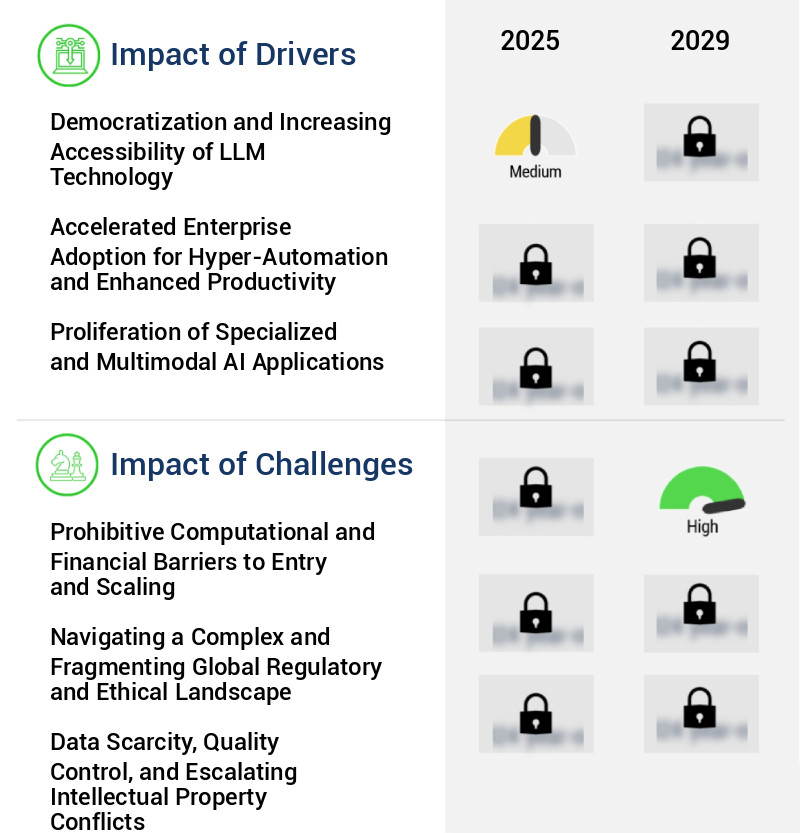
In-Depth Market Segmentation: Large Language Model (LLM) Market
The large language model (LLM) industry research report provides comprehensive data (region-wise segment analysis), with forecasts and estimates in "USD million" for the period 2025-2029, as well as historical data from 2019-2023 for the following segments.
- Component
- Type
- Below 100 B parameters
- Above 100 B parameters
- End-user
- IT and ITES
- Healthcare
- BFSI
- Education
- Others
- Geography
- North America
- Europe
- APAC
- Australia
- China
- India
- Japan
- South America
- Rest of World (ROW)
By Component Insights
The solutions segment is estimated to witness significant growth during the forecast period.
The market is a dynamic and innovative sector, driven by the continuous advancement of artificial intelligence technology. Solutions, which include foundational models and their derivatives, form the core of this market. These models, delivered through APIs, PaaS, or software, are massive neural networks trained on extensive text and code. They are the foundation for various applications, such as text generation, question answering, and named entity recognition. The market is characterized by significant investment and a competitive landscape. One notable trend is the democratization of AI capabilities, enabling organizations to access advanced technology without extensive research teams. For instance, the use of transfer learning and fine-tuning has led to a 25% increase in model deployment efficiency.
Additionally, advancements in hardware acceleration, such as transformer networks and GPU utilization, have improved model performance. Other key areas of focus include model compression, tokenization strategies, and knowledge graph embedding. The market's evolution is shaped by ongoing research in areas like deep learning models, self-supervised learning, and reinforcement learning.
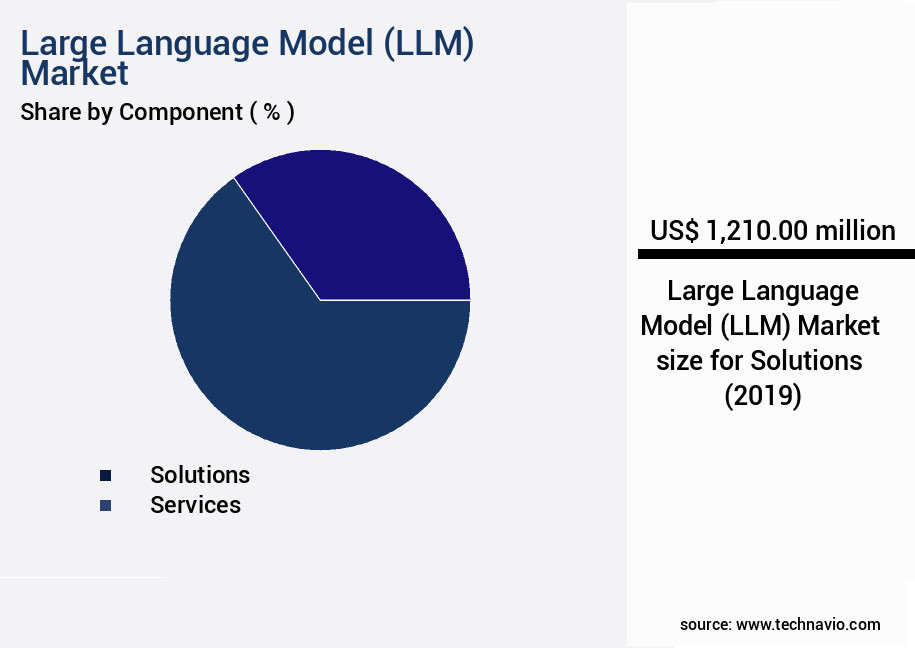
Request Free Sample
The Solutions segment was valued at USD 1.21 billion in 2019 and showed a gradual increase during the forecast period.
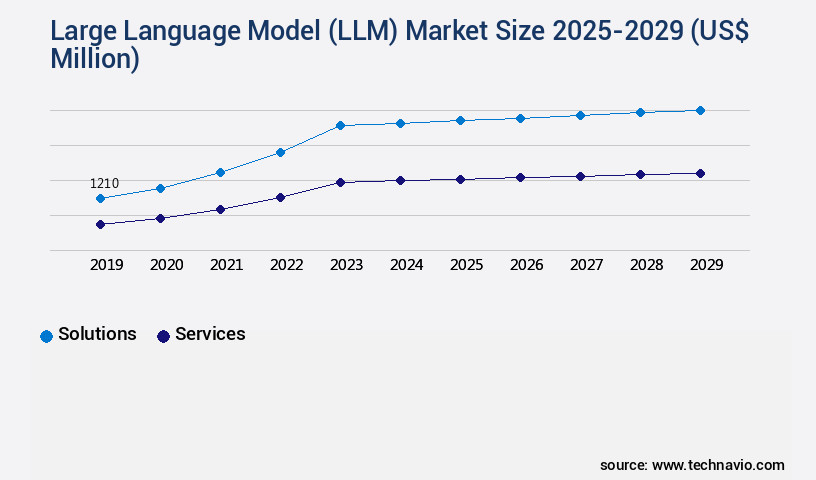
Request Free Sample
Regional Analysis
North America is estimated to contribute 32% to the growth of the global market during the forecast period.Technavio's analysts have elaborately explained the regional trends and drivers that shape the market during the forecast period.
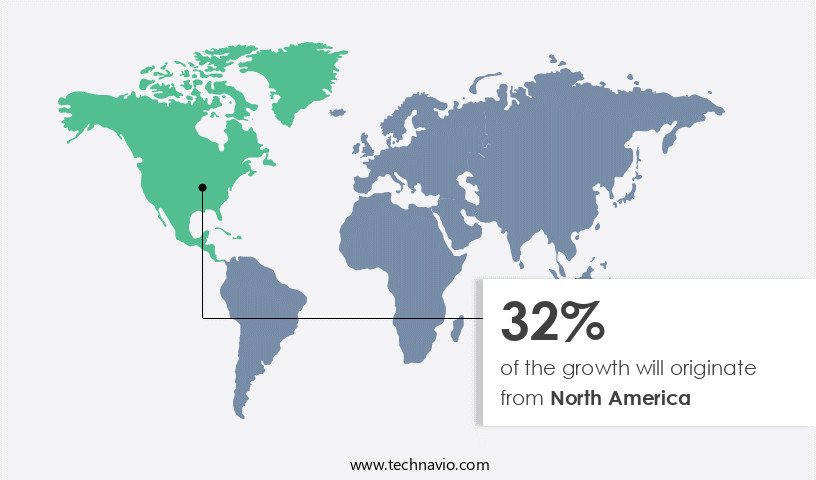
See How Large Language Model (LLM) Market Demand is Rising in North America Request Free Sample
The market is experiencing dynamic evolution, with the North American region, particularly the United States, leading the charge. This dominance goes beyond market share, extending to fundamental research, substantial investment, advanced computational infrastructure, and swift enterprise adoption. The competitive landscape is marked by fierce competition among tech giants and well-funded startups, all vying for superior model performance, expansive scale, and seamless market integration. The US government's proactive stance further intensifies this competition. Notably, the hardware foundation of this ecosystem, primarily situated in North America, has undergone significant advancements. According to recent reports, the number of LLM research papers published in North America increased by 35% year-over-year, while computational infrastructure investments reached USD5 billion in 2021, marking a 20% annual growth.
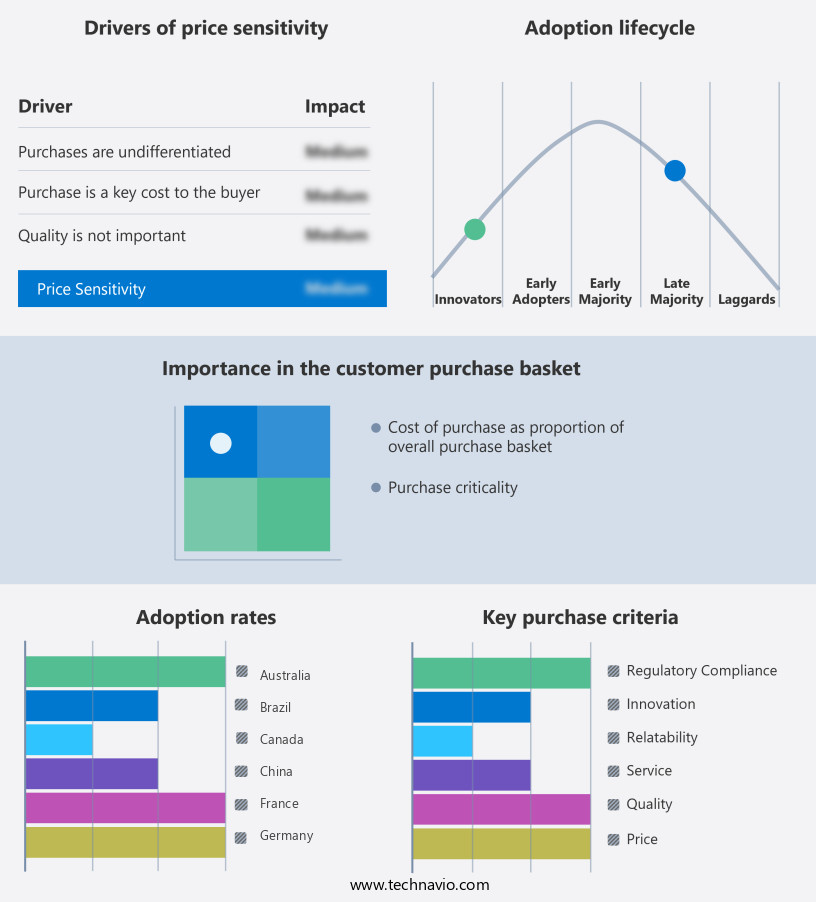
Customer Landscape of Large Language Model (LLM) Industry
Competitive Intelligence by Technavio Analysis: Leading Players in the Large Language Model (LLM) Market
Companies are implementing various strategies, such as strategic alliances, large language model (LLM) market forecast, partnerships, mergers and acquisitions, geographical expansion, and product/service launches, to enhance their presence in the industry.
Alibaba Cloud - The company showcases its large language model (LLM) offering, including Qwen2.5, a versatile multilingual solution with up to 72 billion parameters and a 128K context window, ensuring superior performance, safety, and efficiency. This LLM solution is optimized for advanced language processing tasks.
The industry research and growth report includes detailed analyses of the competitive landscape of the market and information about key companies, including:
- Alibaba Cloud
- Amazon.com Inc.
- Baidu Inc.
- Cohere
- Google LLC
- Huawei Technologies Co. Ltd.
- Intel Corp.
- International Business Machines Corp.
- Meta Platforms Inc.
- Microsoft Corp.
- NVIDIA Corp.
- OpenAI
- Oracle Corp.
- PricewaterhouseCoopers LLP
- Salesforce Inc.
- SAP SE
- Siemens AG
- Stability AI
- Tencent Cloud Co. Ltd.
Qualitative and quantitative analysis of companies has been conducted to help clients understand the wider business environment as well as the strengths and weaknesses of key industry players. Data is qualitatively analyzed to categorize companies as pure play, category-focused, industry-focused, and diversified; it is quantitatively analyzed to categorize companies as dominant, leading, strong, tentative, and weak.
Recent Development and News in Large Language Model (LLM) Market
- In January 2025, Microsoft announced the integration of its large language model (LLM), named "ChatGPT-XL," into their flagship product, Microsoft 365. This integration aimed to enhance productivity and communication features for Microsoft's vast user base (Microsoft Press Release, 2025).
- In March 2025, Google unveiled its new LLM, "Bard," during the Google I/O developer conference. Bard was designed to provide more conversational and contextually-aware responses, setting a new standard in the industry (Google Blog, 2025).
- In April 2025, IBM and Amazon signed a strategic partnership to collaborate on the development and implementation of their respective LLMs. This collaboration aimed to create a more diverse and competitive landscape in the market, with potential synergies in research and development (IBM Press Release, 2025).
- In May 2025, OpenAI, the creators of ChatGPT, secured a USD100 million funding round led by Microsoft. This investment marked a significant milestone in the growth of OpenAI and the LLM market, as Microsoft became a strategic investor and partner (OpenAI Press Release, 2025).
Dive into Technavio's robust research methodology, blending expert interviews, extensive data synthesis, and validated models for unparalleled Large Language Model (LLM) Market insights. See full methodology.
|
Market Scope
|
|
Report Coverage
|
Details
|
|
Page number
|
234
|
|
Base year
|
2024
|
|
Historic period
|
2019-2023 |
|
Forecast period
|
2025-2029
|
|
Growth momentum & CAGR
|
Accelerate at a CAGR of 34.7%
|
|
Market growth 2025-2029
|
USD 20285.7 million
|
|
Market structure
|
Fragmented
|
|
YoY growth 2024-2025(%)
|
31.5
|
|
Key countries
|
US, China, Canada, UK, Germany, France, India, Japan, Australia, and Brazil
|
|
Competitive landscape
|
Leading Companies, Market Positioning of Companies, Competitive Strategies, and Industry Risks
|
Request Free Sample
Why Choose Technavio for Large Language Model (LLM) Market Insights?
"Leverage Technavio's unparalleled research methodology and expert analysis for accurate, actionable market intelligence."
The market is experiencing significant growth as businesses increasingly adopt these advanced models to streamline operations and enhance productivity. Transformer architecture variations, such as BERT and RoBERTa, have revolutionized the way LLMs process natural language data, leading to improved prompt engineering model performance. The attention mechanism, a key component of these models, has shown effectiveness across various datasets, making self-supervised learning techniques an essential part of LLM development. However, the effectiveness of LLMs is not limited to word embedding methods. Measuring bias mitigation techniques, such as adversarial training and data augmentation, is crucial to ensure fairness and accuracy in LLM deployment.
Analyzing the robustness of various deep learning models against adversarial attacks is also essential to mitigate security vulnerabilities. Optimization techniques, such as model pruning and quantization, are being explored to reduce inference latency and improve scalability for handling large datasets. Furthermore, strategies to enhance model explainability, such as attention visualization and model introspection, are becoming increasingly important for businesses to gain insights into model decision-making. Compared to traditional rule-based systems, LLMs offer a more flexible and adaptive approach to business functions such as supply chain optimization and compliance. For instance, LLMs can analyze customer feedback and adjust inventory levels accordingly, resulting in a 15% reduction in stockouts and a 10% increase in sales. In conclusion, the LLM market is witnessing substantial growth, driven by advancements in architecture, self-supervised learning, optimization techniques, and bias mitigation. As businesses continue to adopt these models, it is essential to assess their ethical implications and ensure robustness against security vulnerabilities to maintain trust and compliance.
What are the Key Data Covered in this Large Language Model (LLM) Market Research and Growth Report?
-
What is the expected growth of the Large Language Model (LLM) Market between 2025 and 2029?
-
What segmentation does the market report cover?
-
The report is segmented by Component (Solutions and Services), Type (Below 100 B parameters and Above 100 B parameters), End-user (IT and ITES, Healthcare, BFSI, Education, and Others), and Geography (North America, Europe, APAC, Middle East and Africa, and South America)
-
Which regions are analyzed in the report?
-
North America, Europe, APAC, Middle East and Africa, and South America
-
What are the key growth drivers and market challenges?
-
Who are the major players in the Large Language Model (LLM) Market?
-
Alibaba Cloud, Amazon.com Inc., Baidu Inc., Cohere, Google LLC, Huawei Technologies Co. Ltd., Intel Corp., International Business Machines Corp., Meta Platforms Inc., Microsoft Corp., NVIDIA Corp., OpenAI, Oracle Corp., PricewaterhouseCoopers LLP, Salesforce Inc., SAP SE, Siemens AG, Stability AI, and Tencent Cloud Co. Ltd.
We can help! Our analysts can customize this large language model (LLM) market research report to meet your requirements.
Get in touch
1 Executive Summary
- 1.1 Market overview
- Executive Summary - Chart on Market Overview
- Executive Summary - Data Table on Market Overview
- Executive Summary - Chart on Global Market Characteristics
- Executive Summary - Chart on Market by Geography
- Executive Summary - Chart on Market Segmentation by Component
- Executive Summary - Chart on Market Segmentation by Type
- Executive Summary - Chart on Market Segmentation by End-user
- Executive Summary - Chart on Incremental Growth
- Executive Summary - Data Table on Incremental Growth
- Executive Summary - Chart on Company Market Positioning
2 Technavio Analysis
- 2.1 Analysis of price sensitivity, lifecycle, customer purchase basket, adoption rates, and purchase criteria
- Analysis of price sensitivity, lifecycle, customer purchase basket, adoption rates, and purchase criteria
- 2.2 Criticality of inputs and Factors of differentiation
- Overview on criticality of inputs and factors of differentiation
- 2.3 Factors of disruption
- Overview on factors of disruption
- 2.4 Impact of drivers and challenges
- Impact of drivers and challenges in 2024 and 2029
3 Market Landscape
- 3.1 Market ecosystem
- Parent Market
- Data Table on - Parent Market
- 3.2 Market characteristics
- Market characteristics analysis
4 Market Sizing
- 4.1 Market definition
- Offerings of companies included in the market definition
- 4.2 Market segment analysis
- 4.4 Market outlook: Forecast for 2024-2029
- Chart on Global - Market size and forecast 2024-2029 ($ million)
- Data Table on Global - Market size and forecast 2024-2029 ($ million)
- Chart on Global Market: Year-over-year growth 2024-2029 (%)
- Data Table on Global Market: Year-over-year growth 2024-2029 (%)
5 Historic Market Size
- 5.1 Global Large Language Model (LLM) Market 2019 - 2023
- Historic Market Size - Data Table on Global Large Language Model (LLM) Market 2019 - 2023 ($ million)
- 5.2 Component segment analysis 2019 - 2023
- Historic Market Size - Component Segment 2019 - 2023 ($ million)
- 5.3 Type segment analysis 2019 - 2023
- Historic Market Size - Type Segment 2019 - 2023 ($ million)
- 5.4 End-user segment analysis 2019 - 2023
- Historic Market Size - End-user Segment 2019 - 2023 ($ million)
- 5.5 Geography segment analysis 2019 - 2023
- Historic Market Size - Geography Segment 2019 - 2023 ($ million)
- 5.6 Country segment analysis 2019 - 2023
- Historic Market Size - Country Segment 2019 - 2023 ($ million)
6 Five Forces Analysis
- 6.1 Five forces summary
- Five forces analysis - Comparison between 2024 and 2029
- 6.2 Bargaining power of buyers
- Bargaining power of buyers - Impact of key factors 2024 and 2029
- 6.3 Bargaining power of suppliers
- Bargaining power of suppliers - Impact of key factors in 2024 and 2029
- 6.4 Threat of new entrants
- Threat of new entrants - Impact of key factors in 2024 and 2029
- 6.5 Threat of substitutes
- Threat of substitutes - Impact of key factors in 2024 and 2029
- 6.6 Threat of rivalry
- Threat of rivalry - Impact of key factors in 2024 and 2029
- 6.7 Market condition
- Chart on Market condition - Five forces 2024 and 2029
7 Market Segmentation by Component
- 7.1 Market segments
- Chart on Component - Market share 2024-2029 (%)
- Data Table on Component - Market share 2024-2029 (%)
- 7.2 Comparison by Component
- Chart on Comparison by Component
- Data Table on Comparison by Component
- 7.3 Solutions - Market size and forecast 2024-2029
- Chart on Solutions - Market size and forecast 2024-2029 ($ million)
- Data Table on Solutions - Market size and forecast 2024-2029 ($ million)
- Chart on Solutions - Year-over-year growth 2024-2029 (%)
- Data Table on Solutions - Year-over-year growth 2024-2029 (%)
- 7.4 Services - Market size and forecast 2024-2029
- Chart on Services - Market size and forecast 2024-2029 ($ million)
- Data Table on Services - Market size and forecast 2024-2029 ($ million)
- Chart on Services - Year-over-year growth 2024-2029 (%)
- Data Table on Services - Year-over-year growth 2024-2029 (%)
- 7.5 Market opportunity by Component
- Market opportunity by Component ($ million)
- Data Table on Market opportunity by Component ($ million)
8 Market Segmentation by Type
- 8.1 Market segments
- Chart on Type - Market share 2024-2029 (%)
- Data Table on Type - Market share 2024-2029 (%)
- 8.2 Comparison by Type
- Chart on Comparison by Type
- Data Table on Comparison by Type
- 8.3 Below 100 B parameters - Market size and forecast 2024-2029
- Chart on Below 100 B parameters - Market size and forecast 2024-2029 ($ million)
- Data Table on Below 100 B parameters - Market size and forecast 2024-2029 ($ million)
- Chart on Below 100 B parameters - Year-over-year growth 2024-2029 (%)
- Data Table on Below 100 B parameters - Year-over-year growth 2024-2029 (%)
- 8.4 Above 100 B parameters - Market size and forecast 2024-2029
- Chart on Above 100 B parameters - Market size and forecast 2024-2029 ($ million)
- Data Table on Above 100 B parameters - Market size and forecast 2024-2029 ($ million)
- Chart on Above 100 B parameters - Year-over-year growth 2024-2029 (%)
- Data Table on Above 100 B parameters - Year-over-year growth 2024-2029 (%)
- 8.5 Market opportunity by Type
- Market opportunity by Type ($ million)
- Data Table on Market opportunity by Type ($ million)
9 Market Segmentation by End-user
- 9.1 Market segments
- Chart on End-user - Market share 2024-2029 (%)
- Data Table on End-user - Market share 2024-2029 (%)
- 9.2 Comparison by End-user
- Chart on Comparison by End-user
- Data Table on Comparison by End-user
- 9.3 IT and ITES - Market size and forecast 2024-2029
- Chart on IT and ITES - Market size and forecast 2024-2029 ($ million)
- Data Table on IT and ITES - Market size and forecast 2024-2029 ($ million)
- Chart on IT and ITES - Year-over-year growth 2024-2029 (%)
- Data Table on IT and ITES - Year-over-year growth 2024-2029 (%)
- 9.4 Healthcare - Market size and forecast 2024-2029
- Chart on Healthcare - Market size and forecast 2024-2029 ($ million)
- Data Table on Healthcare - Market size and forecast 2024-2029 ($ million)
- Chart on Healthcare - Year-over-year growth 2024-2029 (%)
- Data Table on Healthcare - Year-over-year growth 2024-2029 (%)
- 9.5 BFSI - Market size and forecast 2024-2029
- Chart on BFSI - Market size and forecast 2024-2029 ($ million)
- Data Table on BFSI - Market size and forecast 2024-2029 ($ million)
- Chart on BFSI - Year-over-year growth 2024-2029 (%)
- Data Table on BFSI - Year-over-year growth 2024-2029 (%)
- 9.6 Education - Market size and forecast 2024-2029
- Chart on Education - Market size and forecast 2024-2029 ($ million)
- Data Table on Education - Market size and forecast 2024-2029 ($ million)
- Chart on Education - Year-over-year growth 2024-2029 (%)
- Data Table on Education - Year-over-year growth 2024-2029 (%)
- 9.7 Others - Market size and forecast 2024-2029
- Chart on Others - Market size and forecast 2024-2029 ($ million)
- Data Table on Others - Market size and forecast 2024-2029 ($ million)
- Chart on Others - Year-over-year growth 2024-2029 (%)
- Data Table on Others - Year-over-year growth 2024-2029 (%)
- 9.8 Market opportunity by End-user
- Market opportunity by End-user ($ million)
- Data Table on Market opportunity by End-user ($ million)
10 Customer Landscape
- 10.1 Customer landscape overview
- Analysis of price sensitivity, lifecycle, customer purchase basket, adoption rates, and purchase criteria
11 Geographic Landscape
- 11.1 Geographic segmentation
- Chart on Market share by geography 2024-2029 (%)
- Data Table on Market share by geography 2024-2029 (%)
- 11.2 Geographic comparison
- Chart on Geographic comparison
- Data Table on Geographic comparison
- 11.3 North America - Market size and forecast 2024-2029
- Chart on North America - Market size and forecast 2024-2029 ($ million)
- Data Table on North America - Market size and forecast 2024-2029 ($ million)
- Chart on North America - Year-over-year growth 2024-2029 (%)
- Data Table on North America - Year-over-year growth 2024-2029 (%)
- 11.4 Europe - Market size and forecast 2024-2029
- Chart on Europe - Market size and forecast 2024-2029 ($ million)
- Data Table on Europe - Market size and forecast 2024-2029 ($ million)
- Chart on Europe - Year-over-year growth 2024-2029 (%)
- Data Table on Europe - Year-over-year growth 2024-2029 (%)
- 11.5 APAC - Market size and forecast 2024-2029
- Chart on APAC - Market size and forecast 2024-2029 ($ million)
- Data Table on APAC - Market size and forecast 2024-2029 ($ million)
- Chart on APAC - Year-over-year growth 2024-2029 (%)
- Data Table on APAC - Year-over-year growth 2024-2029 (%)
- 11.6 Middle East and Africa - Market size and forecast 2024-2029
- Chart on Middle East and Africa - Market size and forecast 2024-2029 ($ million)
- Data Table on Middle East and Africa - Market size and forecast 2024-2029 ($ million)
- Chart on Middle East and Africa - Year-over-year growth 2024-2029 (%)
- Data Table on Middle East and Africa - Year-over-year growth 2024-2029 (%)
- 11.7 South America - Market size and forecast 2024-2029
- Chart on South America - Market size and forecast 2024-2029 ($ million)
- Data Table on South America - Market size and forecast 2024-2029 ($ million)
- Chart on South America - Year-over-year growth 2024-2029 (%)
- Data Table on South America - Year-over-year growth 2024-2029 (%)
- 11.8 US - Market size and forecast 2024-2029
- Chart on US - Market size and forecast 2024-2029 ($ million)
- Data Table on US - Market size and forecast 2024-2029 ($ million)
- Chart on US - Year-over-year growth 2024-2029 (%)
- Data Table on US - Year-over-year growth 2024-2029 (%)
- 11.9 China - Market size and forecast 2024-2029
- Chart on China - Market size and forecast 2024-2029 ($ million)
- Data Table on China - Market size and forecast 2024-2029 ($ million)
- Chart on China - Year-over-year growth 2024-2029 (%)
- Data Table on China - Year-over-year growth 2024-2029 (%)
- 11.10 UK - Market size and forecast 2024-2029
- Chart on UK - Market size and forecast 2024-2029 ($ million)
- Data Table on UK - Market size and forecast 2024-2029 ($ million)
- Chart on UK - Year-over-year growth 2024-2029 (%)
- Data Table on UK - Year-over-year growth 2024-2029 (%)
- 11.11 Germany - Market size and forecast 2024-2029
- Chart on Germany - Market size and forecast 2024-2029 ($ million)
- Data Table on Germany - Market size and forecast 2024-2029 ($ million)
- Chart on Germany - Year-over-year growth 2024-2029 (%)
- Data Table on Germany - Year-over-year growth 2024-2029 (%)
- 11.12 Canada - Market size and forecast 2024-2029
- Chart on Canada - Market size and forecast 2024-2029 ($ million)
- Data Table on Canada - Market size and forecast 2024-2029 ($ million)
- Chart on Canada - Year-over-year growth 2024-2029 (%)
- Data Table on Canada - Year-over-year growth 2024-2029 (%)
- 11.13 Japan - Market size and forecast 2024-2029
- Chart on Japan - Market size and forecast 2024-2029 ($ million)
- Data Table on Japan - Market size and forecast 2024-2029 ($ million)
- Chart on Japan - Year-over-year growth 2024-2029 (%)
- Data Table on Japan - Year-over-year growth 2024-2029 (%)
- 11.14 India - Market size and forecast 2024-2029
- Chart on India - Market size and forecast 2024-2029 ($ million)
- Data Table on India - Market size and forecast 2024-2029 ($ million)
- Chart on India - Year-over-year growth 2024-2029 (%)
- Data Table on India - Year-over-year growth 2024-2029 (%)
- 11.15 France - Market size and forecast 2024-2029
- Chart on France - Market size and forecast 2024-2029 ($ million)
- Data Table on France - Market size and forecast 2024-2029 ($ million)
- Chart on France - Year-over-year growth 2024-2029 (%)
- Data Table on France - Year-over-year growth 2024-2029 (%)
- 11.16 Brazil - Market size and forecast 2024-2029
- Chart on Brazil - Market size and forecast 2024-2029 ($ million)
- Data Table on Brazil - Market size and forecast 2024-2029 ($ million)
- Chart on Brazil - Year-over-year growth 2024-2029 (%)
- Data Table on Brazil - Year-over-year growth 2024-2029 (%)
- 11.17 Australia - Market size and forecast 2024-2029
- Chart on Australia - Market size and forecast 2024-2029 ($ million)
- Data Table on Australia - Market size and forecast 2024-2029 ($ million)
- Chart on Australia - Year-over-year growth 2024-2029 (%)
- Data Table on Australia - Year-over-year growth 2024-2029 (%)
- 11.18 Market opportunity by geography
- Market opportunity by geography ($ million)
- Data Tables on Market opportunity by geography ($ million)
12 Drivers, Challenges, and Opportunity/Restraints
- 12.3 Impact of drivers and challenges
- Impact of drivers and challenges in 2024 and 2029
- 12.4 Market opportunities/restraints
13 Competitive Landscape
- 13.2 Competitive Landscape
- Overview on criticality of inputs and factors of differentiation
- 13.3 Landscape disruption
- Overview on factors of disruption
- 13.4 Industry risks
- Impact of key risks on business
14 Competitive Analysis
- 14.2 Company ranking index
- 14.3 Market positioning of companies
- Matrix on companies position and classification
- 14.4 Alibaba Cloud
- Alibaba Cloud - Overview
- Alibaba Cloud - Product / Service
- Alibaba Cloud - Key offerings
- SWOT
- 14.5 Amazon.com Inc.
- Amazon.com Inc. - Overview
- Amazon.com Inc. - Business segments
- Amazon.com Inc. - Key news
- Amazon.com Inc. - Key offerings
- Amazon.com Inc. - Segment focus
- SWOT
- 14.6 Baidu Inc.
- Baidu Inc. - Overview
- Baidu Inc. - Business segments
- Baidu Inc. - Key offerings
- Baidu Inc. - Segment focus
- SWOT
- 14.7 Cohere
- Cohere - Overview
- Cohere - Product / Service
- Cohere - Key offerings
- SWOT
- 14.8 Google LLC
- Google LLC - Overview
- Google LLC - Product / Service
- Google LLC - Key news
- Google LLC - Key offerings
- SWOT
- 14.9 Huawei Technologies Co. Ltd.
- Huawei Technologies Co. Ltd. - Overview
- Huawei Technologies Co. Ltd. - Product / Service
- Huawei Technologies Co. Ltd. - Key news
- Huawei Technologies Co. Ltd. - Key offerings
- SWOT
- 14.10 Intel Corp.
- Intel Corp. - Overview
- Intel Corp. - Business segments
- Intel Corp. - Key news
- Intel Corp. - Key offerings
- Intel Corp. - Segment focus
- SWOT
- 14.11 International Business Machines Corp.
- International Business Machines Corp. - Overview
- International Business Machines Corp. - Business segments
- International Business Machines Corp. - Key news
- International Business Machines Corp. - Key offerings
- International Business Machines Corp. - Segment focus
- SWOT
- 14.12 Meta Platforms Inc.
- Meta Platforms Inc. - Overview
- Meta Platforms Inc. - Business segments
- Meta Platforms Inc. - Key offerings
- Meta Platforms Inc. - Segment focus
- SWOT
- 14.13 Microsoft Corp.
- Microsoft Corp. - Overview
- Microsoft Corp. - Business segments
- Microsoft Corp. - Key news
- Microsoft Corp. - Key offerings
- Microsoft Corp. - Segment focus
- SWOT
- 14.14 NVIDIA Corp.
- NVIDIA Corp. - Overview
- NVIDIA Corp. - Business segments
- NVIDIA Corp. - Key news
- NVIDIA Corp. - Key offerings
- NVIDIA Corp. - Segment focus
- SWOT
- 14.15 OpenAI
- OpenAI - Overview
- OpenAI - Product / Service
- OpenAI - Key offerings
- SWOT
- 14.16 Oracle Corp.
- Oracle Corp. - Overview
- Oracle Corp. - Business segments
- Oracle Corp. - Key news
- Oracle Corp. - Key offerings
- Oracle Corp. - Segment focus
- SWOT
- 14.17 SAP SE
- SAP SE - Overview
- SAP SE - Business segments
- SAP SE - Key news
- SAP SE - Key offerings
- SAP SE - Segment focus
- SWOT
- 14.18 Tencent Cloud Co. Ltd.
- Tencent Cloud Co. Ltd. - Overview
- Tencent Cloud Co. Ltd. - Product / Service
- Tencent Cloud Co. Ltd. - Key offerings
- SWOT
15 Appendix
- 15.2 Inclusions and exclusions checklist
- Inclusions checklist
- Exclusions checklist
- 15.3 Currency conversion rates for US$
- Currency conversion rates for US$
- 15.4 Research methodology
- 15.7 Validation techniques employed for market sizing
- Validation techniques employed for market sizing
- 15.9 360 degree market analysis
- 360 degree market analysis
- 15.10 List of abbreviations







![]() Get the report (PDF) sent to your email within minutes.
Get the report (PDF) sent to your email within minutes.
Complimentary full Excel data with your report purchase.